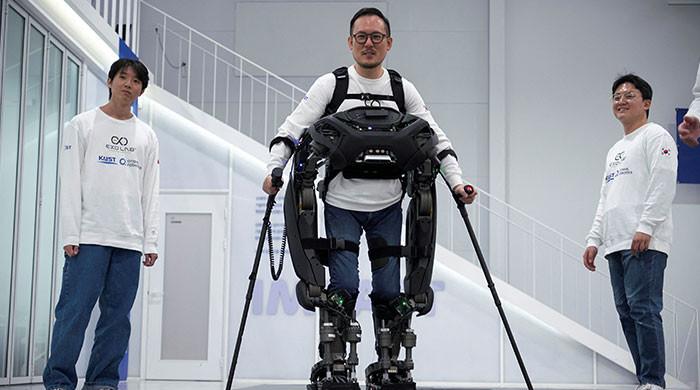DAEJEON: South Korean researchers have developed a lightweight, portable robot that can approach and lock onto paraplegic users, allowing them to walk, maneuver obstacles and climb stairs.
The team at the Korea Advanced Institute of Science and Technology (KAIST) Exoskeleton Laboratory said their goal is to create a robot that integrates seamlessly into the daily lives of people with disabilities.
Kim Seung-hwan, who is a paraplegic and part of the KAIST team, demonstrated the prototype that helped him walk at a speed of 3.2 km/h (2 mph), climb a flight of stairs and take lateral steps to slide on a bank
“It can come up to me wherever I am, even when I’m sitting in a wheelchair, and be used to help me get up, which is one of its most distinctive features,” Kim said.
The powered exoskeleton, called WalkON Suit F1, features an aluminum and titanium composition to weigh 50 kg (110 lb) and is powered by 12 electronic motors that simulate the movements of human joints when walking.
Park Jeong-su, another member of the KAIST team, said he was inspired by the movie “Iron Man.” “After watching Iron Man, I thought it would be cool to be able to help people with a robot in real life.”
To ensure the user’s balance while walking, the robot is equipped with sensors on the soles of the feet and upper body that monitor 1,000 signals per second and anticipate the user’s intended movements.
Lenses on the front of the robot function as eyes that scan its surroundings, identify the height of stairs and detect obstacles to compensate for the lack of sensory ability of users with complete paraplegia, Park said.
Kim Seung-hwan won the gold medal wearing the WalkON Suit F1 in the exoskeleton category at Cybathlon 2024, where developers with various physical disabilities demonstrated assistive robots in eight categories.
“I wanted to tell my son… that I could walk too. I wanted to share a wide range of experiences with him,” Kim said.




